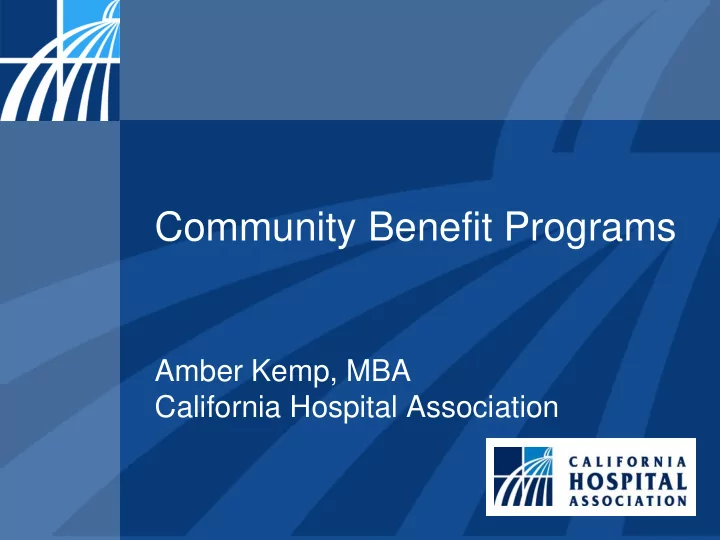

Community Benefit Programs Amber Kemp, MBA California Hospital Association
Overview California’s Community Benefit History Elements of a Community Benefit Program The Community Health Needs Assessment Process What Counts As Community Benefit? Examples of Successful Community Partnerships 2
California’s Community Benefit History
California’s Community Benefit History For more than 20 years, California’s not -for-profit (NFP) hospitals have led the nation in ensuring that vulnerable populations have access to much-needed health care services and improvement programs. In 1994, NFP hospitals’ missions were affirmed by a state law that constructed the framework for conducting a community health needs assessment (CHNA) and developing a community benefit plan. This framework served as a national model for similar provisions in the Affordable Care Act, enacted in 2010. 4
California’s Community Benefit History NFP hospitals, in partnership with community stakeholders, identify and help address significant health needs with programs and activities delivered at the right place and at the right time. Flexibility in local planning and decision making is crucial to meeting the diverse health needs and priorities of communities. Today, NFP hospitals continue their tradition of commitment by investing an estimated $12 billion annually in their communities. At NFP hospitals, all resources are invested in health care services or into their communities. 5
Elements of a Community Benefit Program
Elements of a Community Benefit Program Community benefits are programs or activities that respond to identified community health needs and meet at least one of these objectives: Improve access to health services Enhance public health Increase general knowledge through education and research Relieve government’s burden to improve health 7
Elements of a Community Benefit Program Community health needs can be identified through the following: Conducting a CHNA Responding to a request from a public health agency or community group Involving unrelated partners in a program or activity that improves community health 8
The Community Health Needs Assessment Process
CHNA Process: Partnering with Communities to Assess Community Health Needs Every three years, California’s NFP hospitals, in partnership with their local communities, conduct a CHNA and develop a community benefit plan. Hospitals engage a broad range of organizations and individuals with knowledge and expertise about the community’s health needs to accomplish this important work. 10
CHNA Process: Four Key Steps 11
CHNA Process Step 1: Analyze and Identify Information is collected and analyzed to determine health needs. Sources include quantitative health statistics from publicly available sources, including the public health department. Sources also include qualitative data gathered from interviews, surveys, or community meetings. 12
CHNA Process Step 2: Prioritize Communities may have many health needs, and some are more significant than others. Identified health needs are evaluated to determine the urgency, effectiveness of potential intervention and availability of existing hospital and community resources to address the health need. 13
CHNA Process Step 3: Develop and Implement A formal community benefit plan is developed and implemented to address the prioritized health needs of the community. Partners are identified for many programs, and measurable outcomes and goals are established. 14
CHNA Process Step 4: Publicly Report NFP hospitals’ CHNA and community benefit plans are readily available to the public. Look to California’s Office of Statewide Health Planning and Development (OSHPD) website for the community benefit report and plan. The CHNA and federal implementation strategy are posted on hospitals’ websites. 15
What Counts as Community Benefit?
Community Benefit Programs and Activities Can Take Many Forms Community benefit includes the costs of delivering community health programs or activities, such as: Community health improvement services, including immunizations, free screenings, mobile units serving disadvantaged families, classes on disease management and violence prevention, and school-based health programs. Health professions education programs that train the next generation of health care providers. Research in clinical and community health that contributes to evidence-based practices. 17
Community Benefit Programs and Activities Can Take Many Forms Cash and in-kind contributions to other local NFP organizations and community clinics providing services to underserved populations. Community building activities that protect or improve the community’s health or safety, including housing, economic development, environmental improvements, and leadership development and training for community members. And much more. 18
Community Benefit Programs and Activities Can Take Many Forms NFP hospitals also provide community benefit by helping patients who can’t afford to pay for their health care, such as: Charity care or discounted care. Accepting shortfalls from government-sponsored health care programs, including Medi-Cal and Medicare, the state Children’s Health Insurance Program and medically indigent programs. Subsidized health services for neonatal intensive care, addiction recovery, inpatient psychiatric units, emergency and trauma services, satellite clinics for low-income communities and home health programs. 19
Community Benefit Programs and Activities Can Take Many Forms Although charity care has decreased under the ACA, hospitals continue to assume the responsibility for uncompensated care from chronically underfunded Medi-Cal and Medicare programs. 20
Examples of Successful Community Partnerships
22
San Diego’s City Heights Teaching Kitchen To learn more visit http://www.calhospital.org/san-diego-healthy-kitchens 23
Healthy Smiles Reaches Out to Children in Orange County To learn more visit http://www.calhospital.org/general-information/healthy- 24 smiles-reaches-out-children-orange-county
Mobile Program Outreach Extends to Homeless Shelter To learn more visit http://www.calhospital.org/general-information/mobile- 25 program-outreach-extends-homeless-shelter
Medical & Biotechnology Academy To learn more visit http://www.calhospital.org/general-information/medical- 26 biotechnology-academy
Sacramento’s Street Nurse Program To learn more visit http://www.ourhealthcalifornia.org/blog/article/sacramentos- 27 street-nurse
Questions
Thank You Amber Kemp, MBA Vice President, Health Care Coverage California Hospital Association (916) 552-7543 akemp@calhospital.org
Recommend
More recommend